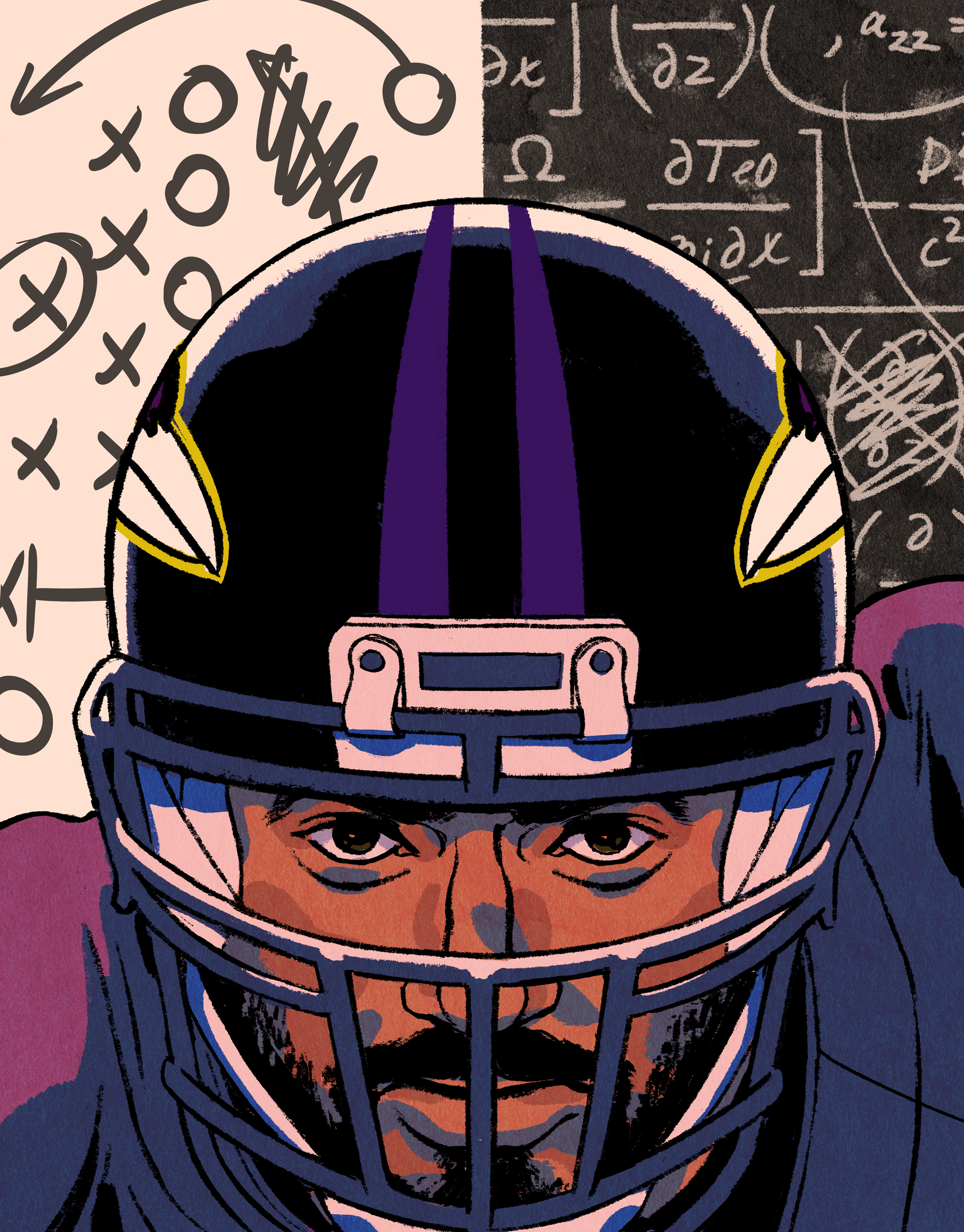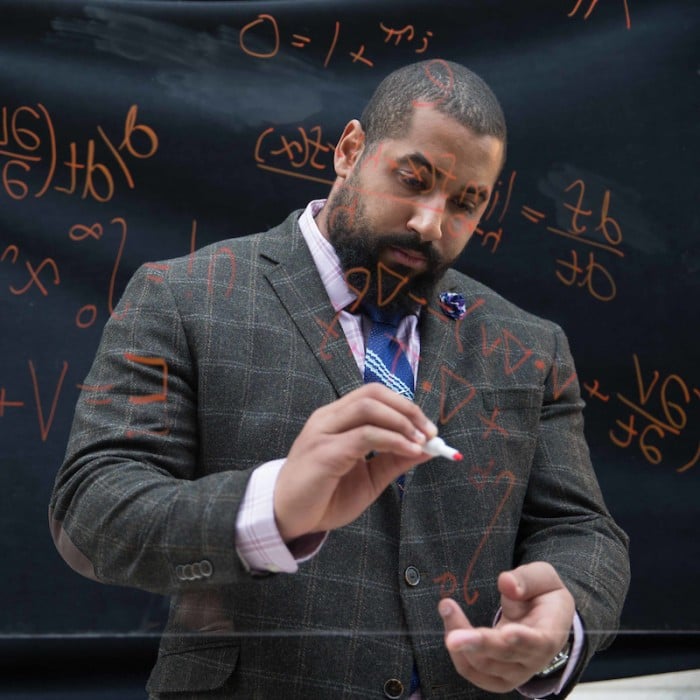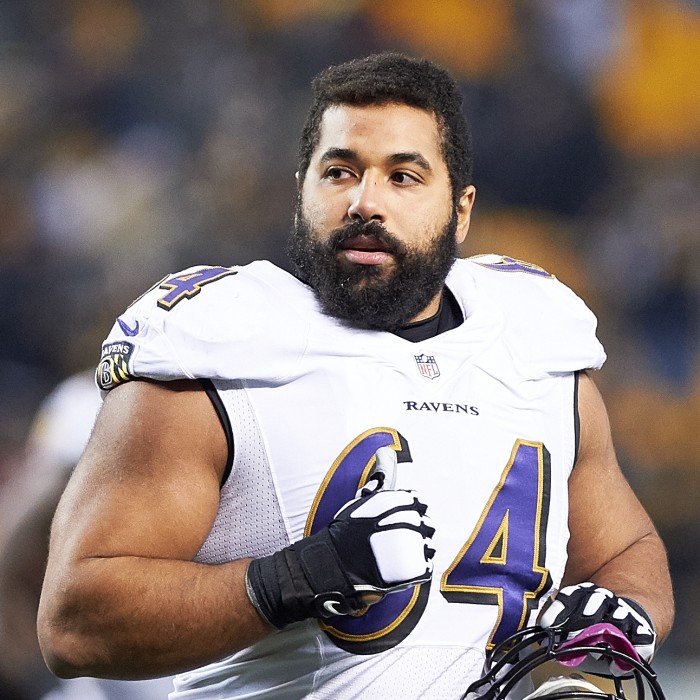From the NFL to MIT: The Double Life of John Urschel

A set diagram depicts the places where different groups of objects overlap. Example: in the United States, there are about 1,700 professional football players, and thousands of people pursuing PhDs in math. In 2017, a diagram of those two sets overlaps in exactly one place.
On an overcast day in late winter, that place is the Norbert Wiener Common Room in MIT’s Department of Mathematics, where John Urschel is sitting at a table, chatting. Urschel is an offensive lineman with the NFL’s Baltimore Ravens, a three-year pro with 40 regular-season games played and a couple of playoff starts on his football résumé. He is also a doctoral candidate in math at MIT who has passed his qualifying exams and has nine published or accepted research papers on his academic résumé.
Yes, there are plenty of bright people in the NFL, and plenty of athletic math students in America. But no one else has his combination of high-level achievement in professional sports and the seminar room.
As a result, Urschel has been profiled in Sports Illustrated and the Washington Post and featured on HBO’s Real Sports; written columns (featuring math puzzles) for The Players’ Tribune (see a sample in Puzzle Corner); and even appeared in a nationally broadcast television commercial last season for Bose headphones, along with J.J. Watt, the superstar defensive end of the Houston Texans. Walk down MIT’s Infinite Corridor at the right time of day and you’ll see a 6'3", 300-pound celebrity athlete striding along with the crowds of students, staff, professors, and tour groups.
But why is a highly paid pro football player grinding through problems in the math study room? The answer becomes evident through the pure enthusiasm Urschel radiates when he talks about his life as a scholar at MIT.


“I really, really like it here,” he says. “We’ve just got such a great collection of so many brilliant mathematicians in different fields, applied and pure mathematicians, under the same roof. I’m just blessed to be around these brilliant people at the pinnacle of their respective fields.”
That enthusiasm has been brewing for most of Urschel’s life. When he was growing up in Buffalo, his mother gave him puzzles to work on; to this day, he explains math to non-mathematicians by calling it a form of puzzle solving. He did not play football, on the other hand, until high school. Yet he did well enough to play as an undergraduate for Penn State, a school he chose partly to improve his prospects of reaching the NFL.
At Penn State, Urschel also started working with Ludmil Zikatanov, a professor with whom he has coauthored four of his nine papers. Those papers cover areas such as spectral graph theory and feature titles like “Spectral Bisection of Graphs and Connectedness”—which appeared in Linear Algebra and Its Applications in the spring of 2014, around the time the Ravens drafted him. Urschel emerged from Penn State in 2013 with both his undergraduate and master’s degrees in math.
“He is the best master’s student that I have ever had,” says Zikatanov. Despite the extraordinary degree of commitment required to play football at his level, Urschel remains fully committed to pursuing math at the highest level, too, Zikatanov says. “He works hard, all the time.”
The 2014 paper Urschel and Zikatanov published together updates a theorem from the 1970s about how to divide a network—picture a social network—into equal parts while cutting as few connections as possible and leaving the connections intact within each half. A 2016 paper the two published together in Linear and Multilinear Algebra (“On the Maximal Error of Spectral Approximation of Graph Bisection”) evaluates how precisely such work can be performed.
“In math, you have to be comfortable with failure,” Urschel says. “In football, that should never be a thing.”
As a doctoral student, Urschel is now working with Michel Goemans, an expert in combinatorial optimization, which seeks optimal solutions to problems with a large but finite set of solutions. This work can be applied to logistics or operations: determining, say, the shortest itinerary for a trip with many stops in it is a well-known use of combinatorial optimization. But whatever subfield of math Urschel pursues, he is likely to bring his characteristic doggedness. “When he gets into a problem, he doesn’t let go,” Zikatanov observes.
If getting ahead in math requires untold hours of deep effort, though, Urschel says that achieving a publishable result is gratifying because of all that labor.
“It’s the sum of just so much work,” he says. “And how often you fail—and how often people collectively fail at a puzzle—increases the implicit toughness of the problem, and how good you feel when you solve a tough problem.” After MIT, and after football, Urschel wants to continue the research he loves as a university professor.
As much as he enjoys discussing math, Urschel can quickly shift to talking about the toughest opponent he has faced on a football field: Miami Dolphins defensive tackle Ndamukong Suh. “Just a freak athlete—his size, athleticism, strength,” he says. “Best defensive lineman I’ve ever gone against.” Among edge rushers, Urschel quickly cites Watt as a tough matchup. “J.J. Watt’s real. The dude is like—I think he weighs 300 pounds, and he is tall, and he is big, and he is fast. And the worst thing is, he’s smart.” And no, Urschel says, he is not just naming Watt because they filmed that Bose commercial together: “I’ve also had to block him.”
Much of the media coverage Urschel receives emphasizes the disparity of his interests. But his two vocations have similarities. After all, both require years of intensive training and a strong competitive drive. In both academia and football, Urschel has advisors and coaches who want him to succeed but are obligated to tell him when he must perform better.
Urschel grants a few parallels between studying at MIT and playing in the NFL, but he says the comparisons go only so far. “In math, you have to be comfortable with failure,” he says. “In football, that should never be a thing.” Working on math problems, he explains, involves trial and error to an extent that would never be tolerated on a football field.
“You have something you want to prove, and you try different ways to get at it,” he says. “You try this way, and it doesn’t work. You try that way—it doesn’t work. Try this way, and it seems to work—then you think about it, and you’re like, ‘No, it doesn’t work.’ You do it again and again and again. And finally, maybe, you get it. And when you get it, it’s an amazing feeling, the best feeling in the world.”
That is certainly a better feeling than the one Urschel experienced two summers ago during Ravens training camp, when he suffered a concussion that kept him out of action for nearly two weeks. And it may seem irrational for a star scholar to expose himself to potential brain damage. But “I accept the risk,” Urschel told the Washington Post last fall, and he confirms that his attitude has not changed. That attitude may also be informed by the fact that his father, a college football player, became a surgeon without evident problems.
Although his mother tries to talk him into quitting at the end of every season, Urschel isn’t ready to give it up. As he wrote in his essay “Why I Still Play Football” in The Players’ Tribune, the allure for him isn’t money or fame. It’s visceral and physical. “There’s a rush you get when you go out on the field, lay everything on the line and physically dominate the player across from you,” he wrote. “This is a feeling I’m (for lack of a better word) addicted to, and I’m hard-pressed to find anywhere else.”
Indeed, it’s the sheer enjoyment he derives from both pursuits that has carried him this far. That pleasure is evident as Urschel pauses, smiles, and circles back to the topic of his MIT studies.
“Did I mention that I really, really like the math department here?”
Update: On July 27, John Urschel retired from the NFL at age 26. Although his announcement came two days after the release of a study linking chronic traumatic encephalopathy (CTE) to playing football, he did not mention the study when writing about his decision on Twitter:
Keep Reading
Most Popular
Large language models can do jaw-dropping things. But nobody knows exactly why.
And that's a problem. Figuring it out is one of the biggest scientific puzzles of our time and a crucial step towards controlling more powerful future models.
How scientists traced a mysterious covid case back to six toilets
When wastewater surveillance turns into a hunt for a single infected individual, the ethics get tricky.
The problem with plug-in hybrids? Their drivers.
Plug-in hybrids are often sold as a transition to EVs, but new data from Europe shows we’re still underestimating the emissions they produce.
Stay connected
Get the latest updates from
MIT Technology Review
Discover special offers, top stories, upcoming events, and more.